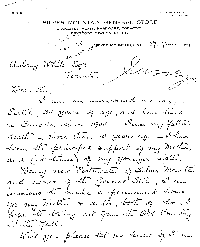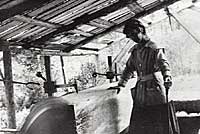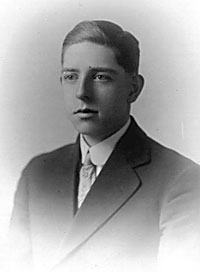Dorothea Mitchell Biography
Born in England in 1877, Dorothea Mitchell is one of Canada's least known, but significant early twentieth century women. Her father was involved in the construction of railways throughout the British Empire, and, after a brief stint in Egypt, he moved the family to what was then known as Bombay in India. While in India, Mitchell witnessed the British Empire at the height of its power and was educated as a "memsahib" or colonial elite, receiving instruction in etiquette, dancing and properly women activities from British Military Officers and local society matrons. Mitchell's mother, however, was disappointed in only having girls and encouraged her daughters (Mitchell and a younger sister Vera) to participate in activities that were not considered practical or consistent with the life of a proper young woman of the nineteenth-century. Mitchell learned carpentry from an undertaker and marksmanship and riding from the same Military officers appointed to teach her proper etiquette.

Photo courtesy National Film Board of Canada
|
Life in India came to an end in the 1890s as Dorothea Mitchell mother's health forced the family to move back to England. Shortly after, Mitchell's father died and, in her own words, she was forced to become "the man of the family." After numerous jobs ranging from domestic help to a nursery governess, in 1904, realising her limited options in England, Mitchell immigrated to Canada influenced by promises made by the Canadian government of free land and a better life waiting. At first settling in Toronto, Dorothea Mitchell worked in a variety of jobs, and, upon receiving word that her mother and sister would soon be joining her, eventually purchased a boarding house. Resulting from a sudden illness that delayed their emigration to Canada, and an urge to explore her adoptive homeland, Mitchell sold the boarding house and answered an ad in the Toronto Globe for companion-help for a mining engineer and his wife operating out of Silver Mountain, Ontario.
No sooner had she arrived when the decline in prices that had plagued the silver industry since the 1890s forced the closure of the mine her employer managed. Not yet wanting to leave the region, in early 1910 Mitchell prevailed upon the CNR to allow her to stay as both station master on the PeeDee line and postmaster in a part-time capacity while she ran her own general store.

Photo courtesy National Film Board of Canada |
Mitchell soon found that her store was not very profitable as most patrons bartered for goods. The most common currency was lumber, and Dorothea Mitchell, half a world away from India, took up her former role as a memsahib, or lady boss, and, coupled also with the more "manly" skills she has been taught in India, purchased a sawmill, hired some workers and became known as the "lady lumberjack."

Dorothea Mitchell's letter to Ministry of Lands and Forests |
Upon receiving news in 1910 that her mother, sister, and "an old family retainer" were coming to Canada, Mitchell took the unprecedented step of petitioning the Ontario government for land under the Homestead Act. After a year of frustration and lies and deceit on the part of the Ministry of Lands and Forests, Mitchell was finally granted a homestead. However, while men were typically granted 160 acres, Mitchell received only 79 as, the Deputy Minister wrote, "while the Department has located you under the Free Grant and Homestead Act for R 140, it is not strictly in accordance with the Act. Not being a married woman you are not strictly entitled to a free grant."

Photo courtesy National Film Board of Canada |
From 1911 to 1920 Dorothea Mitchell operated her sawmill and eventually built, what she fondly referred to, her "bungalow," where she and her mother and sister lived. By 1921, though, Mitchell (now 44) made the decision to retire from the lumber industry and join her sister Vera and Mother in Port Arthur where they had moved the previous year. In the winter of 1921-22, Dorothea Mitchell took courses at the Business College in Port Arthur, and, by the summer of 1922, had achieved enough proficiency that, while staff was on vacation, she was given the task of teaching courses. While teaching, she used her newly earned credentials and took a variety of jobs working as a bookkeeper and checker for local businesses and the CPR freight office in Fort William.
It was while working as a bookkeeper that she met Fred Cooper, a local bakery owner. In the winter of 1929 he approached Mitchell to help organise an amateur cinema society. In April 1929 they formed the Port Arthur Amateur Cinema Society, the first such amateur film group in Canada.

Fred Cooper
Photo courtesy Andy & Laura Carlson
|
Between 1929 and 1931, the Port Arthur Amateur Cinema Society made two complete feature-length films, and nearly completed a third before overextension, a lack of interest caused by the arrival of sound films, and the beginning of the great depression forced the Society to fold. Although short-lived, the Port Arthur Amateur Cinema Societyís first film, "A Race for Ties," was the first amateur feature-length film in Canadian history and Mitchell's role as writer, production manager, actor, editor, wardrobe, and sometimes director possibly makes one of the first independent women feature film makers in Canadian history.
After her sisters and mother's deaths in the early 1930s, Mitchell considered moving to the West Coast. Each time, though, something kept her at the Lakehead. In 1930 at the age of 53 it was a request by community members to become the first secretary-treasurer of the Port Arthur General Hospital. Later, between 1931 and 1934 she operated a series of real estate offices while being actively involved in a variety of charitable organisations such as St. Johnís Anglican Church and, always an ardent supporter of the British Empire, was a prominent member of the Daughters of the Empire.
With the onset of the Second World War in 1939, Dorothea Mitchell responded to the call to take up arms. Enlisting in the Red Cross Societyís transport corps, she fully intended to go overseas, however, following her successful completion of the training program, she was put in charge of training young recruits as, she was later informed, at the age of 63 she was far "too old for overseas service." The Government of Canada put Mitchell in charge of the office of Voluntary Registration of Canadian women. Overseeing an area that covered the Kenora, Rainy River, Thunder Bay, and Algoma districts, in 1940 she was also charged with running registration and the investigation of preferred homes in Port Arthur and Fort William for the British Child Guests section of the Children's Aid Society of Port Arthur and Fort William. In 1941, Mitchell became secretary to the Dependent's Advisory Board for the Thunder Region and remained there until, grudgingly on the advice of her doctor, she left the Lakehead to retire to the West Coast of Canada.
After she settled into her new home in Victoria, Dorothea Mitchell, now age 64, began to distinguish herself in the cultural milieu of British Columbia. She once again became involved in amateur filmmaking by joining the Victoria Amateur Movie Club, and also decided to expand her literary talents by joining the Victoria Branch of the Canadian Author's Association (CAA), becoming secretary soon after. She published numerous short stories based on her life, and, at the age of 92 Lady Lumberjack, a book based on her experiences while living at Silver Mountain between 1909 and 1921, was published by Mitchell Press of Vancouver in 1968. Dorothea Mitchell died in 1976 at the age of 99.
|